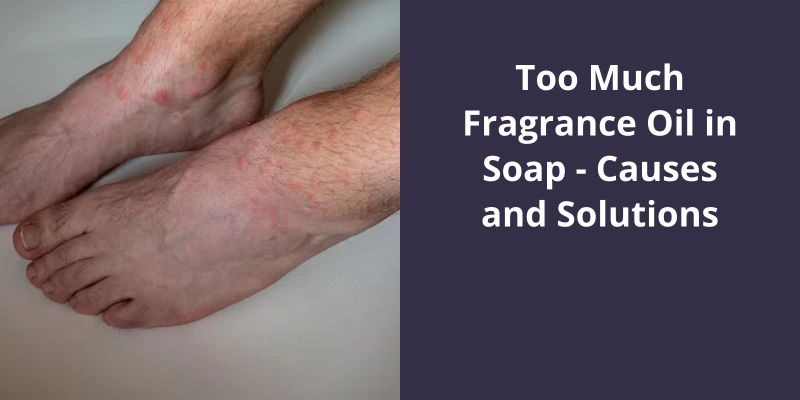If you put too much fragrance oil in soap, it can lead to various problems such as skin irritation or allergic reactions due to the high concentration of chemicals. It can also potentially affect the soap’s ability to clean properly, as the excess oil might interfere with its cleansing properties. Additionally, the soap might lose its shape or consistency, becoming soft and gooey. To resolve this issue, it’s crucial to significantly reduce the amount of fragrance oil used. Measuring carefully and following the recommended guidelines on the fragrance oil package can help to prevent the issue from recurring. As a rule of thumb, typically, you should use around 1 ounce of fragrance oil per pound of soap base.

Can You Put Too Much Fragrance Oil in Soap?
As a soapmaker, it’s important to strike the perfect balance when it comes to adding fragrance oils to your soap. While it may be tempting to add more fragrance oil, doing so can have disastrous consequences.
This is because the fragrance oil can interfere with the chemical reactions needed to create a stable bar of soap. When this happens, the soap can become discolored and start to separate, making it less effective and less appealing to use.
This is because some fragrance oils can be harsh and cause dermatitis or other skin reactions.
How to Properly Measure and Calculate the Right Amount of Fragrance Oil for Soapmaking
- First, determine the total weight of your soap batch in ounces or grams.
- Next, decide on the percentage of fragrance oil you want to use. This will depend on the type of fragrance and your personal preference, but a general guideline is to use 3-5% fragrance oil.
- To calculate how much fragrance oil to use, multiply the total weight of your soap batch by the percentage of fragrance oil. For example, if you’ve a 1 pound (16 ounce) batch of soap and want to use 3% fragrance oil, you’d multiply 16 x 0.03 = 0.48 ounces of fragrance oil.
- Always use a scale to measure the fragrance oil accurately. Don’t rely on measuring spoons or cups, as they aren’t precise enough for soapmaking.
- If you’re using a fragrance oil that’s known to accelerate or rice in soap, you may want to use a lower percentage to avoid issues with the soap.
- Remember to follow any manufacturer guidelines for the fragrance oil you’re using, as they may have specific recommendations for soapmaking.
When making your own body butter, adding fragrance oil can impart a lovely scent to the finished product. However, it’s important to get the amount just right. Adding too much fragrance oil can make the butter overpowering, while not adding enough can result in a lackluster scent. In this article, we’ll explore how much fragrance oil to add to 8 oz of body butter, so you can create the perfect balance of scent and moisturizing properties.
How Much Fragrance Oil for 8 Oz Body Butter?
Fragrance oil is quite a popular ingredient in skincare products, and body butter is no exception. However, adding the right amount can be tricky, especially if youre new to it. Typically, youll want to add 1-2 tablespoons of fragrance oil per 16 oz of body butter. It’s always better to start with less and then add more if needed, as adding too much can result in an overwhelming scent that could even be unpleasant.
Be sure to read the labels and choose scents that are safe for use on skin. Keep in mind that some fragrance oils may cause skin irritation or allergic reactions, so always do a patch test before applying the scent to your entire body. If you experience any negative reactions, discontinue use immediately.
Achieving the perfect scent for your body butter will depend on your own personal preferences. If the scent is too strong, you can try adding more body butter until you reach the desired level of fragrance. Be patient while doing this, as it can take some time for the scent to fully blend into the product. On the other hand, if the fragrance isn’t strong enough, try adding a little more oil. Just a few drops at a time should do the trick.
One way to do this is to use a hand mixer or blender to whip the body butter and fragrance oil together until they’re fully combined. You can also stir it by hand using a spatula, but this may take longer.
Start with a small amount and then add more as needed until you reach your desired scent. Just remember to choose high-quality oils that are safe for use on skin, and be patient while mixing the ingredients together.
There are a few things to keep in mind when adding fragrance to lotion, especially when it comes to how much fragrance oil to use. Adding too much may result in a product that’s too thin or causes skin irritation. Finding the perfect balance between scent and lotion consistency is key. In addition to fragrance oils, essential oils can also be used to add a natural scent to lotion. Let’s take a closer look at how to properly incorporate fragrance into your lotion.
How Much Fragrance Oil to Add to Lotion?
When it comes to adding fragrance oil to lotion, it’s important to keep in mind that too much of a good thing can lead to undesirable consequences. Thus, the key is to add just the right amount of scent to create the perfect balance between fragrance and consistency.
It’s worth noting that adding essential oils to lotion is also a popular option. Essential oils are natural plant extracts that can provide a wide range of benefits, from calming the mind to soothing the skin. However, it’s important to use them sparingly, as they’re highly concentrated and potent.
Remember to start with small amounts and work your way up, and always mix well to ensure even distribution.
Tips for Choosing the Right Fragrance Oil for Your Lotion
- Consider the purpose of your lotion – Is it a relaxing lotion for bedtime or a refreshing lotion for the morning? Choose a fragrance oil that aligns with the purpose of your lotion.
- Test the fragrance oil – Before adding the fragrance oil to your entire lotion batch, test it out with a small amount to make sure it smells the way you want it to.
- Avoid using too much – Fragrance oils can be overpowering, so start with a small amount and add more as needed.
- Choose high-quality fragrance oils – Higher quality oils will have a more accurate and long-lasting scent.
- Consider skin sensitivities – Some fragrances can irritate sensitive skin, so choose a scent that’s safe for all skin types.
- Consider blending scents – Mixing two or more fragrance oils can create a unique scent for your lotion.
- Read reviews – Before purchasing a fragrance oil, read reviews from other lotion makers to see their experiences with the scent.
Now that you know how to dilute fragrance oil for skin, it’s important to keep in mind that using too much can cause skin irritation. It’s always best to start with a small amount and test it on a small area of your skin before applying it all over. With proper dilution, you can safely enjoy your favorite scent without any adverse reactions.
How Do You Dilute Fragrance Oil for Skin?
When it comes to the world of skincare, fragrance oils are often used to give the product a pleasant scent. However, it’s important to know how to properly dilute the fragrance oil in order to avoid any potential skin irritation. This will help to evenly distribute the fragrance oil onto the skin, without causing any greasiness or stickiness.
All you need to do is add 1-2 drops of fragrance oil to a quarter sized amount of lotion or carrier oil. Then, blend the mixture between your hands and apply directly to your skin. It’s important to note that a little goes a long way, so avoid adding too much fragrance oil to your mixture.
One of the most popular carrier oils for diluting fragrance oils is jojoba oil. Jojoba oil is a lightweight, non-greasy oil, making it perfect for skincare products. It’s also a great carrier oil for essential oils as it’s easily absorbed into the skin, leaving it feeling hydrated and nourished.
Sweet almond oil is rich in fatty acids and vitamin E, making it a great emollient for the skin. It’s also known for it’s anti-inflammatory properties, helping to soothe and calm irritated skin.
If you prefer to use a non-scented lotion to dilute your fragrance oil, be sure to choose a lotion that’s free from any additives or fragrances.
Different Types of Carrier Oils and Their Benefits for Skincare
Carrier oils are natural oils derived from plants that are used to dilute essential oils and make them safe for topical use. There are many different types of carrier oils, each with their own unique benefits for skincare. Some popular carrier oils include jojoba oil, which helps balance oil production and moisturize the skin, and rosehip oil, which is high in antioxidants and can help improve skin texture and tone. Other popular carrier oils include argan oil, avocado oil, and coconut oil, each with their own unique properties and benefits for skincare.
While fragrance oils can be a great addition to your skincare routine, it’s important to understand the potential risks involved with using them on your skin. Some fragrances may cause irritation or allergic reactions, while others may contain harmful chemicals. It’s important to choose high-quality, natural fragrance oils and to patch test any new products before using them on your skin regularly.
Is It Safe to Put Fragrance Oil on Your Skin?
However, it’s important to note that not all fragrance oils are created equal. Some fragrance oils contain a high concentration of synthetic chemicals that can be harmful to the skin. It’s important to carefully research the ingredients of the fragrance oil before applying it to your skin. This can help to identify any allergic reactions or skin sensitivities.
This can also help to preserve the scent and make it last longer.
It’s also important to source fragrance oils from reputable suppliers who follow strict standards for purity and safety. It’s important to research the supplier before making a purchase and read reviews from other customers.
Overuse of fragrances can cause skin irritation, headaches, and other health concerns.
Diluting the fragrance oil with a carrier oil and performing a patch test before use can also help to reduce the risk of skin irritation or allergic reactions.
The Differences Between Natural vs. Synthetic Fragrance Oils
- Natural fragrance oils are derived from natural sources such as plants, flowers, and fruits.
- Synthetic fragrance oils are made in a laboratory using chemicals and are designed to mimic the scent of natural fragrances.
- Natural fragrance oils are typically more expensive than synthetic fragrance oils.
- Synthetic fragrance oils are often more stable and have a longer shelf life than natural fragrance oils.
- Natural fragrance oils are considered to be better for the environment as they’re derived from renewable resources.
- Synthetic fragrance oils are often used in products such as cleaning supplies and perfumes due to their ability to hold their scent longer than natural fragrance oils.
Conclusion
In conclusion, creating handmade soap is an enjoyable and creative process that allows for customization and experimentation. There are solutions such as removing a portion of the soap and re-batching it with unscented soap base to achieve the desired fragrance strength.





